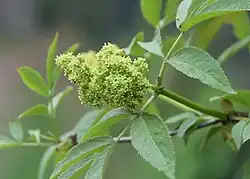Sambucus × strumpfii
| Sambucus × strumpfii | |
|---|---|
| Scientific classification | |
| Kingdom: | Plantae |
| Clade: | Tracheophytes |
| Clade: | Angiosperms |
| Clade: | Eudicots |
| Clade: | Asterids |
| Order: | Dipsacales |
| Family: | Adoxaceae |
| Genus: | Sambucus |
| Species: | S. × strumpfii
|
| Binomial name | |
| Sambucus × strumpfii Gutte[1]
| |
.svg.png)
| |
| It is endemic to Germany[2] | |
Sambucus × strumpfii is a natural hybrid of Sambucus nigra and Sambucus racemosa in the family Viburnaceae endemic to Germany.[2]
Description
Parent species of
Sambucus × strumpfii
Gutte
Sambucus × strumpfii
Gutte
.jpg)
Sambucus nigra L.

Sambucus racemosa L.
It is a shrub.[2]
Taxonomy
It was described by Peter Gutte in 2006.[3] The plant was found by Klaus Strumpf in 1996[4] near Altenburg, Germany[5][6] and was given to the Leipzig Botanical Garden.[4] The type specimen was then collected by Peter Gutte on the 25th of April 2003.[4]
Etymology
The hybrid name strumpfii honours the German botanist Klaus Strumpf.[7]
Distribution and habitat
It is endemic to Germany.[2]
References
- ^ USDA, Agricultural Research Service, National Plant Germplasm System. 2025. Germplasm Resources Information Network (GRIN Taxonomy). National Germplasm Resources Laboratory, Beltsville, Maryland. URL: https://npgsweb.ars-grin.gov/gringlobal/taxon/taxonomydetail?id=468519. Accessed 27 July 2025.
- ^ a b c d Sambucus × strumpfii Gutte. (n.d.). Plants of the World Online. Retrieved July 27, 2025, from https://powo.science.kew.org/taxon/urn:lsid:ipni.org:names:77080337-1
- ^ Gutte, P. (2006). Sambucus racemosa× S. nigra–neu für Deutschland. Haussknechtia, 11, 111-114.
- ^ a b c Sambucus × strumpfii Gutte. (n.d.-b). International Plant Names Index. Retrieved July 27, 2025, from https://www.ipni.org/n/77080337-1
- ^ Isotype of Sambucus x strumpfii Gutte [family ADOXACEAE]. (n.d.). JSTOR. Retrieved July 27, 2025, from https://plants.jstor.org/stable/10.5555/al.ap.specimen.glm162999b
- ^ Jage, H., Klenke, F., & Kummer, V. (2010). Neufunde und bemerkenswerte Bestätigungen von phytoparasitischen Kleinpilzen in Deutschland: Erysiphales (Echte Mehltaupilze). Schlechtendalia, 21, 1-140.
- ^ Worschech, K. & Naturkundemuseum Mauritianum. (2017). „Forscher, Sammler, Sammlungen: Lebenswerke von privat – gesichert im Museum" Erwerb bedeutender Sammlungen durch das Mauritianum in den letzten 10 Jahren Eine Ausstellung anlässlich des Jubiläums „200 Jahre Naturforschende Gesellschaft Altenburg" Gewidmet Egon Jungmann († 11.5.2017). Mauritiana (Altenburg), 32.